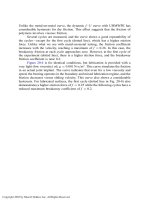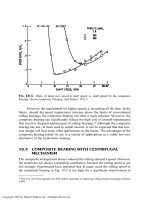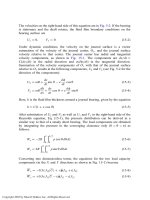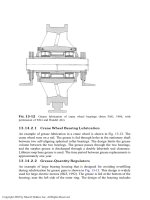Bearing Design in Machinery Episode 1 Part 3 pdf
Bạn đang xem bản rút gọn của tài liệu. Xem và tải ngay bản đầy đủ của tài liệu tại đây (267.11 KB, 16 trang )
direction is,
P ¼
F
a
A
where
A ¼
p
4
ðD
2
1
À D
2
Þ
This is the shoulder area that supports the thrust load. Substituting yields
P ¼
4F
a
pðD
2
1
À D
2
Þ
¼
4 Â 600
pð1:2
2
À 1
2
Þ
¼ 1736 psi
This is within the allowed limit of P
allowed
¼ 2000 psi.
b. Calculation of Average Surface Velocity of Thrust Bearing, V
th
. The
average velocity of a thrust bearing is at the average diameter, ðD
1
þ DÞ=2:
V
th
¼ oR
av
¼ o
D
av
2
where o ¼ 2pN rad=min. Substituting yields
V
th
¼ 2pNR
av
¼
2pNðD
1
þ DÞ
4
¼ 0:5pNðD
1
þ DÞ
Substitution in the foregoing equation yields
V
th
¼ 0:5p Â1000 rev=min ð0:1 þ 0:083Þ ft ¼ 287:5ft=min
This is well within the allowed limit of V
allowed
¼ 1180 ft=min.
c. Calculation of Actual Average PV Value for the Thrust Bearing:
PV ¼ 1736 psi Â287:5ft=min ¼ 500 Â10
3
psi-ft=min
Remark. The imperial units for PV are of pressure, in psi, multiplied by
velocity, in ft=min.
Conclusion. Although the limits of the velocity and pressure are met, the
PV value exceeds the allowed limit for self-lubricated sintered bronze bearing
material, where the PV limit is 110,000 psi-ft=min.
b. Radial Bearing
Calculation of Average Pressure
P ¼
F
r
A
Copyright 2003 by Marcel Dekker, Inc. All Rights Reserved.
where A ¼ LD is the projected area of the bearing. Substitution yields
P ¼
F
r
LD
¼
1200 lbf
1in: Â1in:
¼ 1200 psi
Calculation of Journal Surface Velocity. The velocity is calculated as
previously; however, this time the velocity required is the velocity at the surface
of the 1-inch shaft, D=2.
V
r
¼ o
D
2
¼ 2pn
D
2
¼ p Â1000 rev=min Â0:083 ft ¼ 261 ft=min
Calculation of Average PV Value:
PV ¼ 1200 psi  261 ft=min ¼ 313 Â10
3
psi-ft=min
In a similar way to the thrust bearing, the limits of the velocity and pressure are
met; however, the PV value exceeds the allowed limit for sintered bronze bearing
material, where the PV limit is 110,000 psi-ft=min.
Example Problem 1-2
Calculation of Bearing Forces
In a gearbox, a spur gear is mounted on a shaft at equal distances from two
supporting bearings. The shaft and gear turn together at a speed of 600 RPM. The
gearbox is designed to transmit a maximum power of 5 kW. The gear pressure
angle is f ¼ 20
. The diameter of the gear pitch circle is d
p
¼ 5 in.
Remark. The gear pressure angle f (PA) is the angle between the line of
force action (normal to the contact area) and the direction of the velocity at the
pitch point (see Fig. 1-7). Two standard pressure angles f for common involute
gears are f ¼ 20
and f ¼ 14: 5
. Detailed explanation of the geometry of gears
is included in many machine design textbooks, such as Machine Design,by
Deutschman et al. (1975), or Machine Design, by Norton (1996).
a. Find the reaction force on each of the two bearings supporting the
shaft.
b. The ratio of the two bearings’ length and bore diameter is L=D ¼ 0:5.
The bearings are made of sintered bronze material (PV ¼ 110;000 psi-
ft=min). Find the diameter and length of each bearing that is required in
order not to exceed the PV limit.
Solution
a. Reaction Forces
Given:
Copyright 2003 by Marcel Dekker, Inc. All Rights Reserved.
The tangential force, F
t
, acting on the gear can now be derived from the power,
_
EE:
_
EE ¼ To
where the torque is
T ¼
F
t
d
p
2
Substituting into the power equation:
_
EE ¼
F
t
d
p
o
2
and solving for F
t
and substituting yields
F
t
¼
2
_
EE
d
p
o
¼
2 Â 5000 Nm=s
0:127 m  62:83 rad=s
¼ 1253:2N
In spur gears, the resultant force acting on the gear is F ¼ F
tr
(Fig. 1-7)
cos f ¼
F
t
F
so
F ¼
F
t
cos f
¼
1253:2
cos 20
¼ 1333:6N
The resultant force, F, acting on the gear is equal to the radial component of the
force acting on the bearing. Since the gear is equally spaced between the two
bearings supporting the shaft, each bearing will support half the load, F.
Therefore, the radial reaction, W, of each bearing is
W ¼
F
2
¼
1333:6
2
¼ 666:8N
b. Bearing Dimensions
The average bearing pressure, P,is
P ¼
F
A
Here, A ¼ LD, where D is the journal diameter and A is the projected area of the
contact surface of journal and bearing surface,
P ¼
F
LD
Copyright 2003 by Marcel Dekker, Inc. All Rights Reserved.
The velocity of shaft surface, V ,is
V ¼
D
2
o
Therefore,
PV ¼
W
LD
D
2
o
Since L=D ¼ 0:5, L ¼ 0:5D, substituting and simplifying yields
PV ¼
W
0:5D
2
oD
2
¼
W
D
o
The PV limit for self-lubricated sintered bronze is given in English units,
converted to SI units, the limit is
110;000 psi-ft=min Â35 N=m
2
-m=s ¼ 3;850;000 Pa-m=s
Solving for the journal diameter, D, and substituting yields the diameter of the
bearing:
D ¼
W o
PV
¼
666:8NÂ 62:83 rad=s
3:85 Â10
6
Pa Á m=s
¼ 0:011 m; or D ¼ 11 mm
The length of the bearing, L,is
L ¼ 0:5D ¼ 0:5 Â 11 mm ¼ 5:5mm
The resulting diameter, based on a PV calculation, is very small. In actual design,
the journal is usually of larger diameter, based on strength-of-material considera-
tions, because the shaft must have sufficient diameter for transmitting the torque
from the drive.
Example Problem 1-3
Calculation of Reaction Forces
In a gearbox, one helical gear is mounted on a shaft at equal distances from two
supporting bearings. The helix angle of the gear is c ¼ 30
, and the pressure
angle (PA) is f ¼ 20
. The shaft speed is 3600 RPM. The gearbox is designed to
transmit maximum power of 20 kW. The diameter of the pitch circle of the gear is
equal to 5 in. The right-hand-side bearing is supporting the total thrust load. Find
the axial and radial loads on the right-hand-side bearing and the radial load on the
left-side bearing.
Copyright 2003 by Marcel Dekker, Inc. All Rights Reserved.
Solution
The angular velocity of the shaft, o, is:
o ¼
2pN
60
¼
2p3600
60
¼ 377 rad=s
Torque produced by the gear is T ¼ F
t
d
p
=2. Substituting this into the power
equation,
_
EE ¼ To, yields:
_
EE ¼
F
t
d
p
2
o
Solving for the tangential force, F
t
, results in
F
t
¼
2
_
EE
d
p
o
¼
2 Â 20;000 N-m=s
0:127 m  377 rad=s
¼ 836 N
Once the tangential component of the force is solved, the resultant force, F, and
the thrust load (axial force), F
a
, can be calculated as follows:
F
a
¼ F
t
tan c
F
a
¼ 836 N Âtan 30
¼ 482 N
and the radial force component is:
F
r
¼ F
t
tan f
¼ 836 N Â tan 20
¼ 304 N
The force components, F
t
and F
r
, are both in the direction normal to the shaft
centerline. The resultant of these two gear force components, F
tr
, is cause for the
radial force component in the bearings. The resultant, F
tr
, is calculated by the
equation (Fig. 1-7)
F
tr
¼
ffiffiffiffiffiffiffiffiffiffiffiffiffiffiffiffiffi
F
2
t
þ F
2
r
q
¼
ffiffiffiffiffiffiffiffiffiffiffiffiffiffiffiffiffiffiffiffiffiffiffiffiffi
836
2
þ 304
2
p
¼ 890 N
The resultant force, F
tr
, on the gear is supported by the two bearings. It is a radial
bearing load because it is acting in the direction normal to the shaft centerline.
Since the helical gear is mounted on the shaft at equal distances from both
bearings, each bearing will support half of the radial load,
W
r
¼
F
tr
2
¼
890 N
2
¼ 445 N
However, the thrust load will act only on the right-hand bearing:
F
a
¼ 482 N
Copyright 2003 by Marcel Dekker, Inc. All Rights Reserved.
Example Problem 1-4
Calculation of Reaction Forces
In a gearbox, two helical gears are mounted on a shaft as shown in Fig. 1-1. The
helix angle of the two gears is c ¼ 30
, and the pressure angle (PA) is f ¼ 20
.
The shaft speed is 3600 RPM. The gearbox is designed to transmit a maximum
power of 10 kW. The pitch circle diameter of the small gear is equal to 5 in. and
that of the large gear is of 15 in.
a. Find the axial reaction force on each of the two gears and the resultant
axial force on each of the two bearings supporting the shaft.
b. Find the three load components on each gear, F
t
, F
r
, and F
a
.
Solution
Given:
Helix angle c ¼ 30
Pressure angle f ¼ 20
Rotational speed N ¼ 3600 RPM
Power 10 kW
Diameter of pitch circle (small) d
P1
¼ 5in:
Diameter of pitch circle (large) d
P2
¼ 15 in:
Small Gear
a. Axial Reaction Forces.
The first step is to solve for the tangential force acting on the small gear, F
t
.
It can be derived from the power, E, and shaft speed:
_
EE ¼ To
where the torque is T ¼ F
t
d
p
=2. The angular speed o in rad=sis
o ¼
2pN
60
¼
2p  3600
60
¼ 377 rad=s
Substituting into the power equation yields
_
EE ¼
F
t
d
p
o
2
The solution for F
t
acting on the small gear is given by
F
t
¼
2
_
EE
d
p
o
The pitch diameter is 5 in., or d
p
¼ 0:127 m. After substitution, the tangential
force is
F
t
¼
2 Â 10;000 W
ð0:127 mÞÂð377 rad=sÞ
¼ 418 N
Copyright 2003 by Marcel Dekker, Inc. All Rights Reserved.
The radial force on the gear (F
r
in Fig 1-1) is:
F
r
¼ F
t
tan f
F
r
¼ 418 N Â tan 20
F
r
¼ 152 N
b. Calculation of the Thrust Load, F
a
:
The axial force on the gear is calculated by the equation,
F
a
¼ F
t
tan c
¼ 418 N Âtan 30
¼ 241 N
F
t
¼ 418 N
F
r
¼ 152 N
F
a
¼ 241 N
Large gear
The same procedure is used for the large gear, and the results are:
F
t
¼ 140 N
F
r
¼ 51 N
F
a
¼ 81 N
Thrust Force on a Bearing
One bearing supports the total thrust force on the shaft. The resultant thrust load
on one bearing is the difference of the two axial loads on the two gears, because
the thrust reaction forces in the two gears are in opposite directions (see Fig. 1-1):
F
a
ðbearingÞ¼241 À 81 ¼ 180 N
Problems
1-1 Figure 1-4 shows a drawing of a hydrostatic journal bearing system
that can support only a radial load. Extend this design and sketch a
hydrostatic bearing system that can support combined radial and
thrust loads.
1-2 In a gearbox, a spur gear is mounted on a shaft at equal distances
from two supporting bearings. The shaft and mounted gear turn
together at a speed of 3600 RPM. The gearbox is designed to transmit
a maximum power of 3 kW. The gear contact angle is f ¼ 20
. The
pitch diameter of the gear is d
p
¼ 30 in. Find the radial force on each
of the two bearings supporting the shaft.
The ratio of the two bearings’ length and diameter is
L=D ¼ 0:5. The bearings are made of acetal resin material with the
Copyright 2003 by Marcel Dekker, Inc. All Rights Reserved.
following limits:
Surface velocity limit, V ,is5m=s.
Average surface-pressure limit, P, is 7 MPa.
PV limit is 3000 psi-ft=min.
Find the diameter of the shaft in order not to exceed the stated limits.
1-3 A bearing is made of Nylon sleeve. Nylon has the following limits as
a bearing material:
Surface velocity limit, V ,is5m=s.
Average surface-pressure limit, P, is 6.9 MPa.
PV limit is 3000 psi-ft=min.
The shaft is supported by two bearings, as shown in Fig. 1-6. The
bearing on the left side is under a radial load F
r
¼ 400 N and an axial
load F
a
¼ 200 N . (The bearing on the left supports the axial force.)
The journal diameter is d, and the bearing length L ¼ d. The thrust
load is supported against a shaft shoulder of diameter D ¼ 1: 2d. The
shaft speed is N ¼ 800 RPM. For the left-side bearing, find the
minimum journal diameter d that would result in P, V , and PV
below the allowed limits, in the radial and thrust bearings.
1-4 In a gearbox, one helical gear is mounted on a shaft at equal distances
from two supporting bearings. The helix angle of the gear is c ¼ 30
,
and the pressure angle (PA) is f ¼ 20
. The shaft speed is
1800 RPM. The gearbox is designed to transmit a maximum power
of 12 kW. The diameter of the pitch circle of the gear is 5 in. The
right-hand-side bearing is supporting the total thrust load. Find the
axial and radial load on the right-hand-side bearing and the radial
load on the left-side bearing.
1-5 In a gearbox, two helical gears are mounted on a shaft as shown in
Fig. 1-1. The helix angle of the two gears is f ¼ 30
, and the pressure
angle (PA) is f ¼ 20
. The shaft speed is 3800 RPM. The gearbox is
designed to transmit a maximum power of 15 kW. The pitch circle
diameters of the two gears are 5 in. and 15 in. respectively.
a. Find the axial reaction force on each of the two gears and
the resultant axial force on each of the two bearings
supporting the shaft.
b. Find the three load components on each gear, F
t
, F
r
,and
F
a
.
Copyright 2003 by Marcel Dekker, Inc. All Rights Reserved.
2
Lubricant Viscosity
2.1 INTRODUCTION
For hydrodynamic lubrication, the viscosity, m, is the most important character-
istic of a fluid lubricant because it has a major role in the formation of a fluid film.
However, for boundary lubrication the lubricity characteristic is important. The
viscosity is a measure of the fluid’s resistance to flow. For example, a low-
viscosity fluid flows faster through a capillary tube than a fluid of higher
viscosity. High-viscosity fluids are thicker, in the sense that they have higher
internal friction to the movement of fluid particles relative to one another.
Viscosity is sensitive to small changes in temperature. The viscosity of
mineral and synthetic oils significantly decreases (the oils become thinner) when
their temperature is raised. The higher viscosity is restored after the oils cool
down to their original temperature. The viscosity of synthetic oils is relatively less
sensitive to temperature variations (in comparison to mineral oils). But the
viscosity of synthetic oils also decreases with increasing temperature.
During bearing operation, the temperature of the lubricant increases due to
the friction, in turn, the oil viscosity decreases. For hydrodynamic bearings, the
most important property of the lubricant is its viscosity at the operating bearing
temperature. One of the problems in bearing design is the difficulty of precisely
predicting the final temperature distribution and lubricant viscosity in the fluid
film of the bearing. For a highly loaded bearing combined with slow speed, oils of
Copyright 2003 by Marcel Dekker, Inc. All Rights Reserved.
relatively high viscosity are applied; however, for high-speed bearings, oils of
relatively low viscosity are usually applied.
The bearing temperature always rises during operation, due to friction-
energy loss that is dissipated in the bearing as heat. However, in certain
applications, such as automobile engines, the temperature rise is much greater,
due to the heat of combustion. In these cases, the lubricant is subject to very large
variations of viscosity due to changes in temperature. A large volume of research
and development work has been conducted by engine and lubricant manufac-
turers to overcome this problem in engines and other machinery, such as steam
turbines, that involve a high-temperature rise during operation.
Minimum viscosity is required to secure proper hydrodynamic lubrication
when the engine is at an elevated temperature. For this purpose, a lubricant of
high viscosity at ambient temperature must be selected. This must result in high
viscosity during starting of a car engine, particularly on cold winter mornings,
causing heavy demand on the engine starter and battery. For this reason,
lubricants with less sensitive viscosity to temperature variations would have a
distinct advantage. This has been the motivation for developing the multigrade
oils, which are commonly used in engines today. An example of a multigrade oil
that is widely used in motor vehicle engines is SAE 5W-30. The viscosity of SAE
5W-30 in a cold engine is about that of the low-viscosity oil SAE 5W, while its
viscosity in the hot engine during operation is about that of the higher-viscosity
oil SAE 30. The viscosity of synthetic oils is also less sensitive to temperature
variations, in comparison to regular mineral oils, and the development of
synthetic oils during recent years has been to a great extent motivated by this
advantage.
It is important to mention that the viscosity of gases, such as air, reveals an
opposite trend, increasing with a rise in temperature. This fact is important in the
design of air bearings. However, one must bear in mind that the viscosity of air is
at least three orders of magnitude lower than that of mineral oils.
2.2 SIMPLE SHEAR FLOW
In Fig. 2-1, simple shear flow between two parallel plates is shown. One plate is
stationary and the other has velocity U in the direction parallel to the plate. The
fluid is continuously sheared between the two parallel plates. There is a sliding
motion of each layer of molecules relative to the adjacent layers in the x direction.
In simple shear, the viscosity is the resistance to the motion of one layer of
molecules relative to another layer. The shear stress, t, between the layers
increases with the shear rate, U =h (a measure of the relative sliding rate of
adjacent layers). In addition, the shear stress, t, increases with the internal friction
between the layers; that is, the shear stress is proportional to the viscosity, m,of
the fluid.
Copyright 2003 by Marcel Dekker, Inc. All Rights Reserved.
where e
x
is the displacement (one-time displacement in the x direction) and G is
the elastic shear modulus of the solid.
Whenever there is viscous flow, shear stresses must be present to overcome
the cohesive forces between the molecules. In fact, the cohesive forces and shear
stress decrease with temperature, which indicates a decrease in viscosity with an
increase in temperature. For the analysis of hydrodynamic bearings, it is
approximately assumed that the viscosity, m, is a function of the temperature
only. However, the viscosity is a function of the pressure as well, although this
becomes significant only at very high pressure. Under extreme conditions of very
high pressures, e.g., at point or line contacts in rolling-element bearings or gears,
the viscosity is considered a function of the fluid pressure.
2.3 BOUNDARY CONDITIONS OF FLOW
The velocity gradient at the solid boundary is important for determining the
interaction forces between the fluid and the solid boundary or between the fluid
and a submerged body. The velocity gradient, du=dy, at the boundary is
proportional to the shear stress at the wall. An important characteristic of fluids
is that the fluid adheres to the solid boundary (there are some exceptions; oil does
not adhere to a Teflon wall). For most surfaces, at the boundary wall, the fluid has
identical velocity to that of the boundary, referred to as the non-slip condition.
The intermolecular attraction forces between the fluid and solid are relatively
high, resulting in slip only of one fluid layer over the other, but not between the
first fluid layer and the solid wall. Often, we use the term friction between the
fluid and the solid, but in fact, the viscous friction is only between the fluid and
itself, that is, one fluid layer slides relative to another layer, resulting in viscous
friction losses.
Near the solid boundary, the first fluid layer adheres to the solid surface
while each of the other fluid layers is sliding over the next one, resulting in a
velocity gradient. Equation (2-1) indicates that the slope of the velocity profile
(velocity gradient) is proportional to the shear stress. Therefore, the velocity
gradient at the wall is proportional to the shear stress on the solid boundary.
Integration of the viscous shear forces on the boundary results in the total force
caused by shear stresses. This portion of the drag force is referred to as the skin
friction force or viscous drag force between the fluid and a submerged body. The
other portion of the drag force is the form drag, which is due to the pressure
distribution on the surface of a submerged body.
Oils are practically incompressible. This property simplifies the equations,
because the fluid density, r, can be assumed to be constant, although this
assumption cannot be applied to air bearings. Many of the equations of fluid
mechanics, such as the Reynolds number, include the ratio of viscosity to density,
Copyright 2003 by Marcel Dekker, Inc. All Rights Reserved.
r, of the fluid. Since this ratio is frequently used, this combination has been given
the name kinematic viscosity, n:
n ¼
m
r
ð2-3Þ
The viscosity m is often referred to as absolute viscosity as a clear distinction from
kinematic viscosity.
2.4 VISCOSITY UNITS
The SI unit of pressure, p, as well as shear of stress, t, is the Pascal
(Pa) ¼ Newtons per square meter [N=m
2
]. This is a small unit; a larger unit is
the kilopascal ðkPaÞ¼10
3
Pa.
In the imperial (English) unit system, the common unit of pressure, p,as
well as of shear stress, t, is lbf per square inch (psi).
The conversion factors for pressure and stress are:
1Pa¼ 1:4504 Â10
À4
psi
1 kPa ¼ 1:4504 Â10
À1
psi
2.4.1 SI Units
From Eq. (2-1) it can be seen that the SI unit of m is ½N-s=m
2
or [Pa-s]:
m ¼
t
du=dy
¼
N=m
2
ðm=sÞ=m
¼ N-s=m
2
The SI units of kinematic viscosity, n, are ½m
2
=s:
n ¼
m
r
¼
N-s=m
2
N-s
2
=m
4
¼ m
2
=s
2.4.2 cgs Units
An additional cgs unit for absolute viscosity, m, is the poise [dyne-s=cm
2
. The
unit of dyne-seconds per square centimeter is the poise, while the centipoise (one
hundredth of a poise) has been widely used in bearing calculations, but now has
been gradually replaced by SI units.
The cgs unit for kinematic viscosity, n, is the stokes (St) [cm
2
=s]; a smaller
unit is the centistokes (cSt), cSt ¼ 10
À2
stokes. The unit cSt is equivalent to
½mm
2
=s.
Copyright 2003 by Marcel Dekker, Inc. All Rights Reserved.
2.4.3 Imperial Units
In the imperial (English) unit system, the unit of absolute viscosity, m, is the reyn
[lbf-s=in:
2
] (named after Osborne Reynolds) in pounds (force)-seconds per square
inch. The imperial unit for kinematic viscosity, n, is [in:
2
=s], square inches per
second.
Conversion list of absolute viscosity units, m:
1 centipoise ¼ 1:45 Â 10
À7
reyn
1 centipoise ¼ 0:001 N-s=m
2
1 centipoise ¼ 0.01 poise
1 reyn ¼ 6:895 Â 10
3
N-s=m
2
1 reyn ¼ 6:895 Â10
6
centipoise
1 N-s=m
2
¼ 10
3
centipoise
1 N-s=m
2
¼ 1:45 Â10
À4
reyn
2.4.4 Saybolt Universal Seconds (SUS)
In addition to the preceding units, a number of empirical viscosity units have been
developed. Empirical viscosity units are a measure of the flow time of oil in a
laboratory test instrument of standard geometry. The most common empirical
viscosity unit in the United States is the Saybolt universal second (SUS). This
Saybolt viscosity is defined as the time, in seconds, required to empty out a
volume of 60 cm
3
of fluid through a capillary opening in a Saybolt viscometer.
There are equations to convert this Saybolt viscosity to other kinematic vis-
cosities, and the fluid density is required for further conversion to absolute
viscosity, m.
The SUS is related to a standard viscometer (ASTM specification D 88).
This unit system is widely used in the United States by commercial oil
companies. The following equation converts t (in SUS) into kinematic viscosity,
n, in centistoke (cSt) units:
nðcStÞ¼0:22t À
180
t
ð2-4Þ
Lubrication engineers often use the conversion chart in Fig. 2-2 to convert from
kinematic viscosity to absolute viscosity, and vice versa. Also, the chart is
convenient for conversion between the unit systems.
2.5 VISCOSITY^TEMPERATURE CURVES
A common means to determine the viscosity at various temperatures is the ASTM
viscosity–temperature chart (ASTM D341). An example of such a chart is given
Copyright 2003 by Marcel Dekker, Inc. All Rights Reserved.
2.6 VISCOSITY INDEX
Lubricants having a relatively low rate of change of viscosity versus temperature
are desirable, particularly in automotive engines. The viscosity index (VI) is a
common empirical measure of the level of decreasing viscosity when the
temperature of oils increases. The VI was introduced as a basis for comparing
Pennsylvania and Gulf Coast crude oils. The Pennsylvania oil exhibited a
relatively low change of viscosity with temperature and has been assigned a VI
of 100, while a certain Gulf Coast oil exhibited a relatively high change in
viscosity with temperature and has been assigned a VI of 0. The viscosity-versus-
temperature curve of all other oils has been compared with the Pennsylvania and
Gulf Coast oils. The viscosity index of all other oils can be determined from the
slope of their viscosity–temperature curve, in comparison to VI ¼ 0 and
VI ¼ 100 oils, as illustrated in Fig. 2-4. Demonstration of the method for
determining the viscosity index from various viscosity–temperature curves is
presented schematically in Fig. 2-4. The viscosity index of any type of oil is
determined by the following equation:
VI ¼
L ÀU
L ÀH
 100 ð2-5Þ
FIG. 2-3 Viscosity–temperature chart.
Copyright 2003 by Marcel Dekker, Inc. All Rights Reserved.
above 7000 kPa. But in such cases, the temperature is relatively high at this
region, and this effect tends to compensate for any increase in viscosity by
pressure. However, in elastohydrodynamic lubrication of ball bearings, gears, and
rollers, the maximum pressure is much higher and the increasing viscosity must
be considered in the analysis. Under very high pressure, above 140,000 kPa
(20,000 psi), certain oils become plastic solids.
Barus (1893) introduced the following approximate exponential relation of
viscosity, m, versus pressure, p:
m ¼ m
0
e
ap
ð2-6Þ
Here, m
0
is the absolute viscosity under ambient atmospheric pressure and a is the
pressure-viscosity coefficient, which is strongly dependent on the operating
temperature.
Values of the pressure-viscosity coefficient, a ½m
2
=N, for various lubri-
cants have been measured. These values are listed in Table 2-1.
A more accurate equation over a wider range of pressures has been
proposed by Rhoelands (1966) and recently has been used for elastohydro-
dynamic analysis. However, since the Barus equation has a simple exponential
form, it has been the basis of most analytical investigations.
TABLE 2-1 Pressure-Viscosity Coefficient, a ½m
2
=N, for Various Lubricants
Temperature, t
m
Fluid 38
C99
C 149
C
Ester 1:28 Â10
À8
0:987 Â10
À8
0:851 Â10
À8
Formulated ester 1.37 1.00 0.874
Polyalkyl aromatic 1.58 1.25 1.01
Synthetic paraffinic oil 1.77 1.51 1.09
Synthetic paraffinic oil 1.99 1.51 1.29
Synthetic paraffinic oil plus antiwear additive 1.81 1.37 1.13
Synthetic paraffinic oil plus antiwear additive 1.96 1.55 1.25
C-ether 1.80 0.980 0.795
Superrefined naphthenic mineral oil 2.51 1.54 1.27
Synthetic hydrocarbon (traction fluid) 3.12 1.71 0.937
Fluorinated polyether 4.17 3.24 3.02
Source: Jones et al., 1975.
Copyright 2003 by Marcel Dekker, Inc. All Rights Reserved.
2.8 VISCOSITY AS A FUNCTION OF SHEAR
RATE
It has been already mentioned that Newtonian fluids exhibit a linear relationship
between the shear stress and the shear rate, and that the viscosity of Newtonian
fluids is constant and independent of the shear rate. For regular mineral and
synthetic oils this is an adequate assumption, but this assumption is not correct
for greases. Mineral oils containing additives of long-chain polymers, such as
multigrade oils, are non-Newtonian fluids, in the sense that the viscosity is a
function of the shear rate. These fluids demonstrate shear-thinning characteristics;
namely, the viscosity decreases with the shear rate. The discipline of rheology
focuses on the investigation of the flow characteristics of non-Newtonian fluids,
and much research work has been done investigating the rheology of lubricants.
The following approximate power-law equation is widely used to describe
the viscosity of non-Newtonian fluids:
m ¼ m
0
@u
@y
nÀ1
ð0 < n < 1Þð2-7Þ
The equation for the shear stress is
t ¼ m
0
@u
@y
nÀ1
@u
@y
ð2-8Þ
An absolute value of the shear-rate is used because the shear stress can be positive
or negative, while the viscosity remains positive. The shear stress, t, has the same
sign as the shear rate according to Eq. (2-8).
2.9 VISCOELASTIC LUBRICANTS
Polymer melts as well as liquids with additives of long-chain polymers in
solutions of mineral oils demonstrate viscous as well as elastic properties and
are referred to as viscoelastic fluids. Experiments with viscoelastic fluids show
that the shear stress is not only a function of the instantaneous shear-rate but also
a memory function of the shear-rate history. If the shear stress is suddenly
eliminated, the shear rate will decrease slowly over a period of time. This effect is
referred to as stress relaxation. The relaxation of shear stress takes place over a
certain average time period, referred to as the relaxation time. The characteristics
of such liquids are quite complex, but in principle, the Maxwell model of a spring
and a dashpot (viscous damper) in series can approximate viscoelastic behavior.
Under extension, the spring has only elastic force while the dashpot has only
viscous resistance force. According to the Maxwell model, in a simple shear flow,
Copyright 2003 by Marcel Dekker, Inc. All Rights Reserved.









